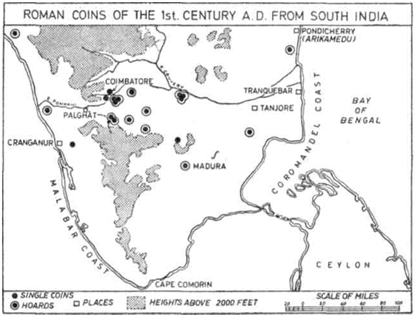south-west of Madras, have produced more than the whole of the rest of the sub-continent put together. From the Coimbatore district alone there are at least 11 1st-century hoards, running in the aggregate to many hundreds of gold and silver coins. As in all such cases, the first step is to refer to the map. The district of Coimbatore is approached by two major rivervalleys, that of the Cauvery from the east coast and that of the Ponnani from the west. It lies at the point where the Eastern Ghats, swinging westwards, merge into the Western Ghats and conspire with them to leave a transverse gap, about 20 miles wide and only 1,000 ft. high, between east and west. To-day through this, the Ponnani or Pālghāt or Coimbatore gap, the railway from Madras and the Carnatic plain penetrates to Calicut and Cochin; and the traditional use of this route is indicated by the legend which lands St. Thomas on the Malabar coast near Cranganore and takes him thence overland to the Madras coast.3 Along this same route crowd the coins now in question (Fig. 1). Along it at first, we cannot doubt,  Fig. 1 came the ancient traffic from Muziris (Cranganore) and Nelcynda to Podouke emporion and Khaberis emporion (Arikamedu and Tranquebar) ------------------------------------------------------------------------------------------------------------------ 3 Warmington, p. 83. |